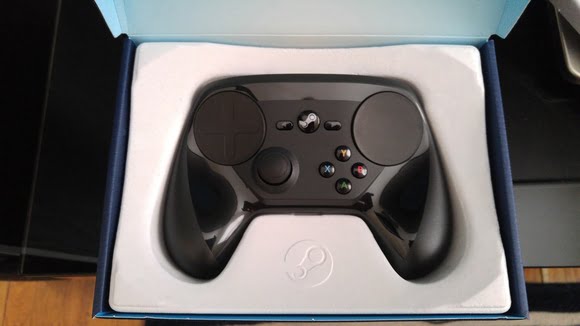A lot.
And I think you’ll like it too.
Further reading!
Valve’s $50 Steam Link is the game streaming solution you want—most of the time
Alienware Steam Machine review: Valve’s vanguard for PC gaming in the living room
Steam Machines unleashed: Impressions from one week in a Steam-powered living room
Open-ended

In part I love the Steam Controller because you can futz around with it. You can tweak whatever you don’t like, you can fine-tune the controls until you’ve got them just so. This is a PC gamepad, designed with the openness of the PC in mind—and that’s a big deal. In fact, I’d wager this is the most important piece of hardware Valve’s putting out in its Steam Machine blitz, moreso than Steam Link and even the Steam Machines themselves. Why? Because without the Steam Controller, there is no Steam Machine or Steam Link.
It’s not like this is the only remappable controller on the PC. It’s not. Using Joy2Key or what-have-you, you can easily swap the buttons around on your Xbox 360/Xbox One/DualShock controller even if developers didn’t bother building that functionality into the game.
But that’s like changing a car’s paint job and calling it a “custom build” in comparison to the Steam Controller. What I find fascinating about the Steam Controller is you can fundamentally change the way it works—and, in the process, completely shake up how you interface with certain games.
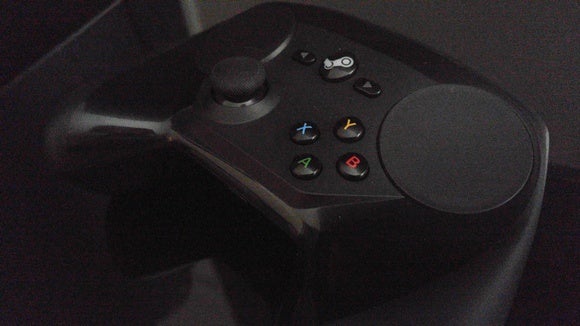 Hayden Dingman
Hayden DingmanThe two haptic touchpads are the key. No surprise—they’re what the entire thing was built around. But I don’t think I truly understood their potential until I spent some time with the controller. Each touchpad can be remapped to five different input modes.
- Directional Pad (D-Pad): This one’s obvious. The left haptic pad even has a vaguely D-pad shaped cross embedded in it. This is useful for switching guns in a shooter, for instance.
- Button pad: A bit less intuitive, but basically you can map four additional A/B/X/Y buttons to the pad—especially useful for keyboard-heavy games with a lot of hotkeys.
- Joystick move/camera: This is by far the weirdest mode. The Steam Controller tries to emulate the behavior of a joystick, so the closer your thumb gets to the edge of the pad the faster you move/turn the camera/whatever. It doesn’t work that well though, and you can see why Valve eventually added an actual analog stick onto the controller for movement.
- Scroll wheel: Easy. It’s your mouse’s scroll wheel, but done on a trackpad. Scroll your finger clockwise for one action, counter-clockwise for another. Good for switching through weapons.
- Mouse: This is where the Steam Controller really shines. Any PC capable of seamlessly switching between controlling the camera on a mouse and controller can run a setup Valve’s calling “Gamepad with High Precision Camera/Aim.” You move with the left stick, but the right haptic pad functions something like a trackball—not physically, since there is no ball to speak of, but the haptics fool your thumb into believing that’s what you’re aiming with.
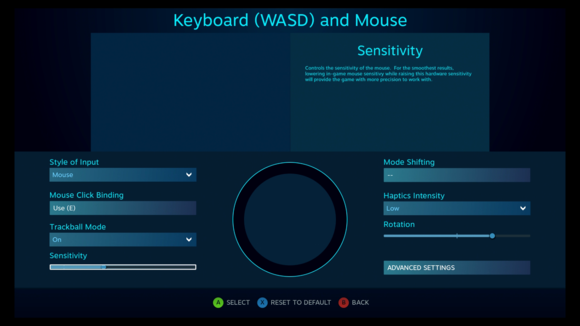
It’s hard to explain, but trust me when I say it’s the best control scheme the Steam Controller has to offer. I first discovered it while playing Portal 2, and I’ve since set it up in every game I can find that supports it. The only problem is some games lock the mouse when you plug in a gamepad, which makes this mode impossible. Valve’s apparently working with developers to make sure that doesn’t happen moving forward, but for now you might find some games where it won’t work.
It’s also worth noting that all of the front controls can be set to any of these modes—you can, for instance, make the analog stick work like a four-button input, which is actually how Valve tricks the controller into playing WASD games like Half-Life 2. Or you can make the A/B/X/Y buttons work like a D-pad. Or whatever you want, really.
And every single control can be mapped to multiple inputs using Mode Shifting. If you’ve played the Assassin’s Creed games on a controller, you’ll know what I mean. One button on the controller becomes a modifier key, so holding down the Right Grip could make the A/B/X/Y buttons function temporarily as different outputs.
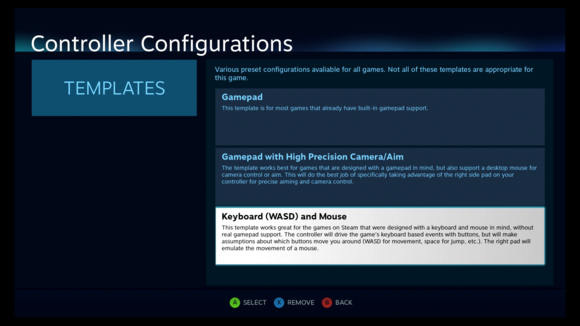
Even weirder, you could make it so the right haptic pad controls your camera—except when you hold down the Right Grip, at which time it controls your movement. Or becomes a scroll wheel. Or make it so every time you pull the left trigger to aim down sights, the trackpad sensitivity simultaneously drops to give you more precision.
The PC in your living room
But I don’t love the Steam Controller because it’s infinitely remappable. That’s a feature. It’s indicative of Valve’s open approach to the system hardware (and by extension its trust in users and developers) but otherwise a meaningless technical achievement.
The experiences the Steam Controller opens up—that’s what matters. I’m not necessarily interested in a discussion about whether you could play games that already work well on a controller on this controller. The short answer is yes, you can. Third-person action games work great. And for shooters, I feel you get some degree of greater accuracy than you get with a standard dual-joystick setup. It’s not the precision of a mouse, but it’s closer.
Point-and-click adventures, though. 4X and real-time strategy games, though. City builders. MOBAs. These are experiences that have traditionally been considered “PC only,” and for good reason—they’re reliant on a mouse and/or keyboard, and the joystick is a poor substitute.
This week I played Civilization V on my couch. I played Deponia on my couch. I played Cities Skylines on my couch. Hell, I played Baldur’s Gate on my couch!
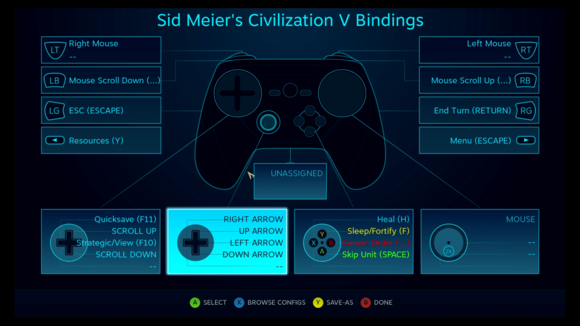
It’s not always a perfect experience. The text in Civ V, for instance, is miniscule even on my fairly large TV. Baldur’s Gate asked me to name a character and then I realized I had no keyboard—although the software keyboard in the Steam overlay will work in a pinch. But those are kinks that can be worked out in the future as developers (potentially) learn to keep the living room in mind even for PC games. Growing pains.
The games worked, though. Games that have traditionally been confined to the bedroom or the office or whatever now run—and run well—on the TV, whether through a dedicated Steam Machine or Steam Link.
And it’s changed the way I think about entire genres. The point-and-click adventure, for instance. It’s such a story-heavy genre, such a low-key and relaxed and minimally-interactive genre—it’s perfect for couches, for sharing with other people in the room who might not play a lot of games but are interested in watching. PC gaming has always been more of a solitary pursuit when compared to console gaming, but not necessarily any longer.
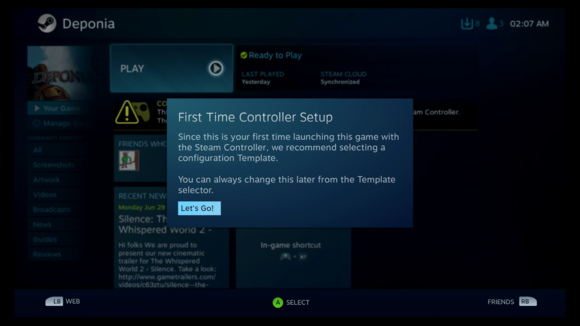
Will it replace your keyboard and mouse? Of course not. Will it replace your PC’s Xbox/PC controller? Eh, for some people maybe. Others, not.
It’s carved out a niche, though—one I plan to take advantage of. This week’s been revelatory in terms of the types of experiences I play in the living room, and that’s where the Steam Controller’s strength lies for me.
Learning curve
The hard part is, of course, getting used to the damn thing. I started out playing games the way I’ve seen my parents, for instance, playing games—moving, then turning the camera, then moving again. As I said it took me maybe three days to get comfortable. It may take you more or less time.
It’s a weird contraption. That single analog stick, the huge haptic pads, the batteries (two AAs) which slot into the grips—this is an unconventional beast. And it’s big, too. It took me a while to figure out how to hold the thing comfortably, as the weight and balance are at odds with any other controller I’ve used.
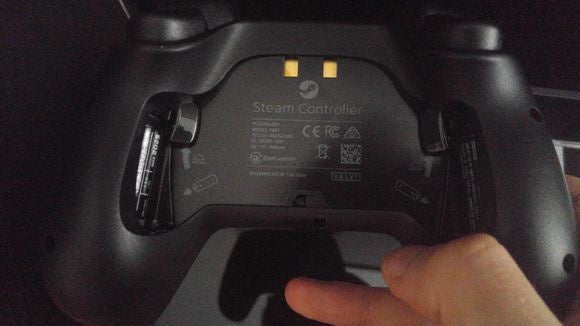 Hayden Dingman
Hayden DingmanDespite its Frankenstein appearance, I think the Steam Controller’s actually easier to grasp than a standard dual-stick setup though. I’ve spent almost twenty years with Xbox/PlayStation controllers at this point so it’s hard to judge, but having seen people try to learn how to manipulate two sticks? Ugh. The Steam Controller still requires some creative muscle memory, but it’s a more familiar interface—lots of people have used a laptop trackpad at this point who’ve never used an analog stick.
More difficult is learning to experiment, to be open to new control schemes. There’s a chance some people get the Steam Controller, play a game that’s defaulted to the “fake joystick” setup, and give up immediately. I wouldn’t blame them. I did it the first night, playing Spec Ops: The Line and losing my temper because I couldn’t figure out why it felt so wrong.
But I think this problem will go away over time. Some developers have already implemented great control schemes—Paradox, for instance, has created a custom setup for Cities Skylines that functions admirably. Others won’t put in the work, but the community can create and upload custom templates for each game. Whenever Valve’s own templates don’t get the job done, I have no doubt someone else will put in the time.
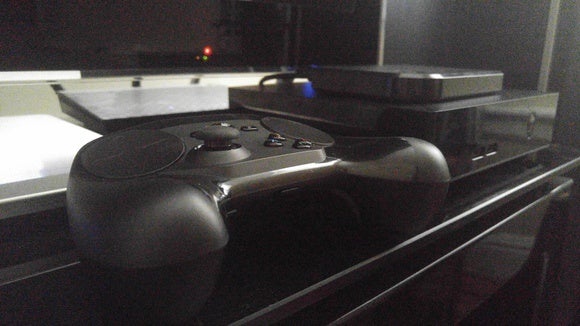 Hayden Dingman
Hayden DingmanBottom line
The Steam Machine army and Valve’s Steam Link might get most of the attention, but they’re ultimately known quantities. Yes, they’re made (or at least backed) by Valve and that makes them interesting to the gaming community, but they’re just computers. Some are powerful. Some are not. But they are at heart black boxes that play or stream video games.
The Steam Controller is the real story, here. It’s an elegant solution to a seemingly insurmountable problem—“How do you play every PC game ever made on a single input device?” As I said, without the Steam Controller there is no Steam Machine.
Give it three days, five days, a week. Put in the effort, and I think you’ll be pleased with what opens up to you. Do I think we’ll see pros using the Steam Controller to play Dota 2 anytime soon? No. At least not at a high level.
But for a lazy Sunday? Bringing the PC out to your couch has never been easier.
Editor’s note: This article originally published as an impressions piece on October 16, 2015, but was updated to review status on November 10.
[“source -pcworld”]


